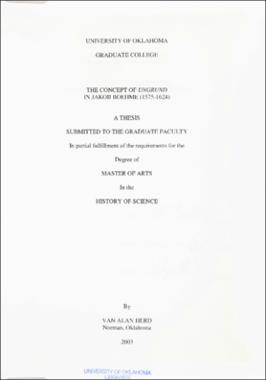| dc.description.abstract | This study is an exposition of the key concept of Ungrund as developed by Jakob Boehme (1575-1624) in his last major work, the Mysterium Magnum of 1624. Until lately largely ignored by the history of science community, the thought of this sixteenth century philosopher and theologian is of far-reaching significance. One of the founders of the academic discipline of the history of science, Alexandre Koyre (1892-1964), studied Boehme in a magisterial historiography with his 1928 La Philosophie de Jacob Boehme.
The first chapter situates Boehme in his historical and cultural contexts. I do not attempt to explore historiographical issues surrounding Boehme so much as trace the history of the concept of Ungrund. This section is dependent upon archival material brought to light by Andrew Weeks and an earlier historian, John Joseph Stoudt, which details the political currents in Silesia at the time of Boehme, including the Court of Rudolph II. I refer to Boehme's supporter, Bartholomaeus Schultz (Scultetus), a Paracelsian who served as Mayor of Görlitz, and who had been trained as a mathematician in Leipzig and Wittenberg. Schultz was a friend of Tycho Brahe who also had a long-distance professional relationship with Johannes Kepler who had visited Görlitz in 1607. Schultz may have been instrumental in having a copy of the Astronomia Nova produced during Kepler's visit. Scultetus also brought to Görlitz a motley assortment of persons who figure prominently in the history of science, among whom were the alchemists Alexander Seton and Michael Sendivogius.
The second chapter defines Boehme's seminal concept of Ungrund, an idea which has strongly influenced the history of science in many ways. I define the term according to its use in Boehme's last major work, the Mysterium Magnum of 1622. Ungrund can best be defined as an atopical negation which has the status of a paradox or negation in the laws of logic. The Greeks used two terms to describe negation, ουκ ον, and µη ον. The first describes a negation which is absolute; a negation which is totally devoid of any ontological status altogether. I argue that Boehme used the term in his late writings. The second term, µη ον, denominates a relative nothingness. This is the familiar "primordial chaos" or "matrix" posited by many classical writers as that out of which the natural order is created or, more accurately, out of which it emanates. It is indeed true that Boehme uses Ungrund in his early works to describe a relative nothingness. However, later in his career he shifts usages; perhaps under the influence of Scultetus and the Görlitz Paracelsian Circle among whom were his friends Tobias Kober, Abraham Walther (the well-known chemist), and Kurtz (a prominent physician). To indicate a relative nothingness, in the 1622 Mysterium Magnum and all his works thereafter, Boehme uses "matrix" or Salitter. When he does use Ungrund in these later works, he indicates an absolute negation, devoid of ontological status. Indeed, in his 1624 Mysterium Magnum, a philosophical and exegetical commentary on the Book of Genesis, Boehme conjoins two concepts, creatio ex nihilo and creatio ex aliquo. In this section I also examine in brief his concept of God Himself becoming out of this Ungrund through an iterative process which preserves the traditional dogma of Divine aseity.
The second chapter also explores a key misunderstanding of the term Ungrund as found in Principe and Weeks' study of Boehme's alchemy, in which is perpetuated the claim set forth by many other contemporary philosophers and historians of science who equate the term with such concepts as Meister Eckhardt's Abgrund.
The third chapter explores ways in which Boehme influenced two key figures in the history of early modem science, Isaac Newton and Robert Boyle (1627-1691). B. J. Gibbons has noted that "there is in fact a superficial resemblance between Newton's system and Boehme's: both construct the universe as pervaded by mysterious forces of attraction and repulsion. " Gibbons believes there is a clear influence of Boehme on Newton but that historians of science have not taken this seriously.
I conclude that Newton was, indeed, influenced by Jakob Boehme by examining the evidence in support of Gibbons' suggestion that Newton's "demonstration that white light can be broken up into a spectrum of colours ... was devised to test a metaphysical and religious hypothesis rather than a purely physical one." Newton investigated an idea that had been discussed amongst the Cambridge Platonists which they had derived from Boehme "that underlying the various different types of material substance in the universe there was also a single, pure, spiritual substance ... white light had been suggested as a candidate." I examine Gibbons' claim that Newton hoped to demonstrate the presence of the Ungrund with his refracting prism, and that this was the central idea around which the impressive company of Cambridge Platonists gathered, of which group Newton was a prominent member.
In my concluding section, I examine Boyle's philosophical motivations for undertaking vacuum experiments. According to Gibbons, Jenkins, and Principe, Boyle constructed his elaborate air pumps in the attempt to evacuate all matter from the vacuum chamber so as to empirically demonstrate the (non)existence of the Ungrund. | |
